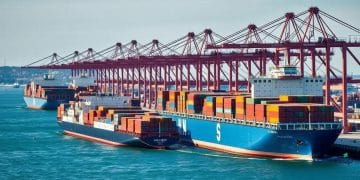Global trade slowdown: what it means for economies

The global trade slowdown is primarily driven by economic fluctuations, shifting trade policies, and supply chain disruptions, requiring businesses to adapt through technology and enhanced sustainability practices.
Global trade slowdown has become a pressing issue that influences the economic landscape around the world. With shifting trade policies and market dynamics, how is your business adapting to these changes?
Understanding the causes of global trade slowdown
The global trade slowdown is a complex issue with multiple causes. Understanding these factors can help businesses adapt and strategize for the future. Let’s explore some of the primary reasons behind this trend.
Economic Factors
One major cause is economic fluctuations across different regions. When economies grow slower than expected, demand for imports also decreases. This can lead to fewer goods being transported internationally, contributing to the slowdown.
- Recession in major economies
- Fluctuating currency values
- Changes in consumer spending patterns
Moreover, inflation rates can impact purchasing power, further complicating trade dynamics. A rise in prices often leads countries to reassess their import levels, which directly affects global trade.
Political and Social Factors
Trade policies and agreements also play a crucial role. Political unrest can result in unstable trading environments. When governments implement tariffs or quotas, international trade can be disrupted, leading to a decrease in overall trade volume.
- Uncertainty in trade agreements
- Increased protectionism
- Geopolitical tensions affecting trade routes
Furthermore, social factors, such as changes in labor markets and workforce issues, can hinder production and logistics, which are vital for maintaining adequate trade levels. Companies must navigate these challenges effectively to remain competitive.
In addition to these factors, technological advancements and shifts in consumer behavior are crucial. The rise of e-commerce has changed how goods are distributed, but it also requires businesses to adapt quickly to new market realities. As consumers increasingly seek faster shipping and more efficiency, traditional trade methods may face pressure.
To grasp the full picture of the global trade slowdown, it’s essential to examine these intertwined causes. By staying informed and understanding these dynamics, businesses can better position themselves to respond to current and future challenges.
Effects on emerging markets and developed nations

The effects of the global trade slowdown are felt differently in emerging markets compared to developed nations. Each group faces unique challenges and opportunities as trade dynamics shift.
Impact on Emerging Markets
For emerging markets, the slowdown can lead to slower economic growth. Many of these countries depend heavily on exports for economic stability. A reduction in demand from major economies can severely impact their trade balance.
- Reduced access to foreign investments
- Decline in export revenues
- Increased unemployment rates
Moreover, emerging markets may struggle to compete in a global environment that favors more established economies. The lack of infrastructure and investment can hinder their ability to adapt and innovate.
Challenges for Developed Nations
Developed nations, on the other hand, also face significant impacts from the **global trade slowdown**. While they may have more robust economies, the interconnectivity of global markets means that no country is immune to the effects of reduced trade.
- Supply chain disruptions
- Higher production costs
- Increased economic uncertainty
As these nations navigate through challenges, they often look to diversify their markets. This can include exploring emerging markets as potential trade partners or shifting focus to domestic production.
Understanding the differences in how emerging and developed nations respond to a global trade slowdown is crucial. This knowledge can help policymakers and businesses create strategies that enhance resilience and adaptability in uncertain times.
Strategies for businesses to navigate slowdowns
During a global trade slowdown, businesses must adopt innovative strategies to survive and thrive. Understanding the right approach can empower companies to navigate these challenging times.
Enhancing Supply Chain Management
One strategy involves improving supply chain management. Companies should streamline their operations to reduce costs and increase efficiency. Effective supply chains can help businesses remain competitive even when trade is down.
- Invest in technology to track inventory
- Build strong relationships with suppliers
- Diversify supply sources to minimize risks
By focusing on these areas, businesses can mitigate disruptions and enhance productivity.
Adapting to Consumer Behavior
Another key strategy is adapting to changing consumer behavior. As buyers become more selective, businesses must understand trends and preferences. Implementing feedback systems to gather insights can be effective.
- Offer personalized products and services
- Enhance customer engagement through social media
- Utilize data analytics to anticipate needs
By adjusting offerings according to consumer demands, companies can build loyalty and increase sales.
Pivoting to online sales channels is also essential. With an increase in e-commerce, businesses can reach wider audiences, leading to potential revenue growth. Investing in digital platforms can help companies adapt and thrive.
Finally, companies should focus on their financial health. Reducing unnecessary expenses and increasing cash reserves can help businesses withstand downturns. Conducting regular financial reviews and adjusting budgets can ensure stability during uncertain times.
Implementing these strategies can prepare businesses to face the challenges posed by a global trade slowdown. Each strategy, when executed effectively, can play a crucial role in maintaining operations and ensuring long-term success.
The role of technology in mitigating impacts

Technology plays a crucial role in mitigating the impacts of a global trade slowdown. It offers solutions that help businesses operate more efficiently during challenging times.
Improving Supply Chain Efficiency
One significant advantage of technology is its ability to streamline supply chains. Automation and data tracking make it easier to manage inventory and logistics. By using advanced software, companies can predict demand and adjust their operations accordingly.
- Implementing real-time tracking systems for shipments
- Utilizing data analytics for forecasting
- Automating warehouse processes to reduce labor costs
These tools enable more precise management of resources, reducing waste and lowering costs.
Enhancing Communication
Effective communication is vital during a global trade slowdown. Technology helps facilitate this by integrating various communication platforms. Businesses can maintain consistent contact with suppliers and customers, ensuring smooth operations.
- Using messaging apps for quick updates
- Establishing video conferencing for remote meetings
- Employing collaborative platforms for team projects
By enhancing communication, companies can swiftly address any challenges that arise and maintain strong relationships across the supply chain.
Another critical role of technology is enhancing customer engagement. Digital marketing tools allow businesses to connect with consumers directly. They can tailor marketing strategies based on data analytics, focusing efforts on what resonates with their audience.
This engagement not only helps retain existing customers but also attracts new ones, even during a downturn. In addition to marketing, using e-commerce platforms can significantly expand a company’s reach, providing access to a broader market.
Technology also supports financial management during challenging periods. Companies can use software for budgeting and forecasting to ensure they stay on top of their finances. This insight allows for better decision-making and can help prevent cash flow issues.
Overall, leveraging technology is essential for businesses seeking to mitigate the impacts of a global trade slowdown. By improving efficiency, communication, customer engagement, and financial management, companies can navigate these challenges more effectively.
Future outlook of global trade dynamics
The future outlook for global trade dynamics is both complex and promising. As economies recover from recent slowdowns, several trends are shaping how trade will function in the coming years.
Increased Digital Trade
One significant trend is the growth of digital trade. As more businesses move online, the reliance on e-commerce platforms is expected to rise. This shift can create new opportunities for both emerging and developed markets by simplifying access to international consumers.
- Expansion of online marketplaces
- Greater emphasis on digital marketing strategies
- Innovation in payment systems for cross-border transactions
With technology advancing, businesses that embrace these changes may find themselves at the forefront of the evolving trade landscape.
Shifting Trade Policies
Another factor that will impact the future of global trade is the adjustment of trade policies. Countries may adopt more protectionist measures, impacting how goods flow across borders. Understanding these policies will be crucial for businesses aiming to operate internationally.
- Potential for new tariffs and trade agreements
- Changes in regulations affecting imports and exports
- Negotiation of regional trade partnerships
Companies will need to stay informed about these shifts to adapt their strategies accordingly.
Environmental sustainability is also emerging as a key consideration in global trade. As businesses and consumers alike place more value on sustainability, trade practices will likely evolve to reflect these priorities. Companies may focus more on eco-friendly logistics and supply chain practices to meet consumer expectations.
Furthermore, the pandemic has highlighted the importance of resilience in supply chains. Businesses are now looking to diversify their suppliers, which can reduce risks associated with over-reliance on any single source. This diversification can enhance stability, allowing companies to better weather future disruptions.
Overall, the future of global trade dynamics is expected to be shaped by these interconnected trends. By proactively adapting to the changing landscape, businesses can position themselves for success in this evolving environment.
In summary, understanding global trade dynamics is essential for businesses today
The global trade slowdown has prompted many changes, but it also presents new opportunities for growth and adaptation.
By embracing technology, enhancing supply chains, and staying informed on trade policies, companies can navigate these challenges effectively. Additionally, focusing on sustainability and resilience in supply chains will be crucial for future success.
As markets evolve, businesses that are proactive in adapting to these changes will be better positioned to thrive in the competitive global landscape.
Ultimately, staying agile and informed will empower businesses to turn challenges into opportunities for innovation and growth.
FAQ – Frequently Asked Questions about Global Trade Dynamics
What are the main causes of the global trade slowdown?
The main causes include economic fluctuations, changes in trade policies, and disruptions in supply chains.
How can technology help businesses during a trade slowdown?
Technology can improve supply chain efficiency, enhance communication, and enable better customer engagement through e-commerce.
What should businesses focus on to adapt to changing trade dynamics?
Businesses should focus on enhancing sustainability, diversifying supply sources, and staying informed about trade policies to navigate challenges.
What does the future of global trade look like?
The future of global trade is shaped by increased digital trade, shifting trade policies, and a focus on resilience and sustainability.





